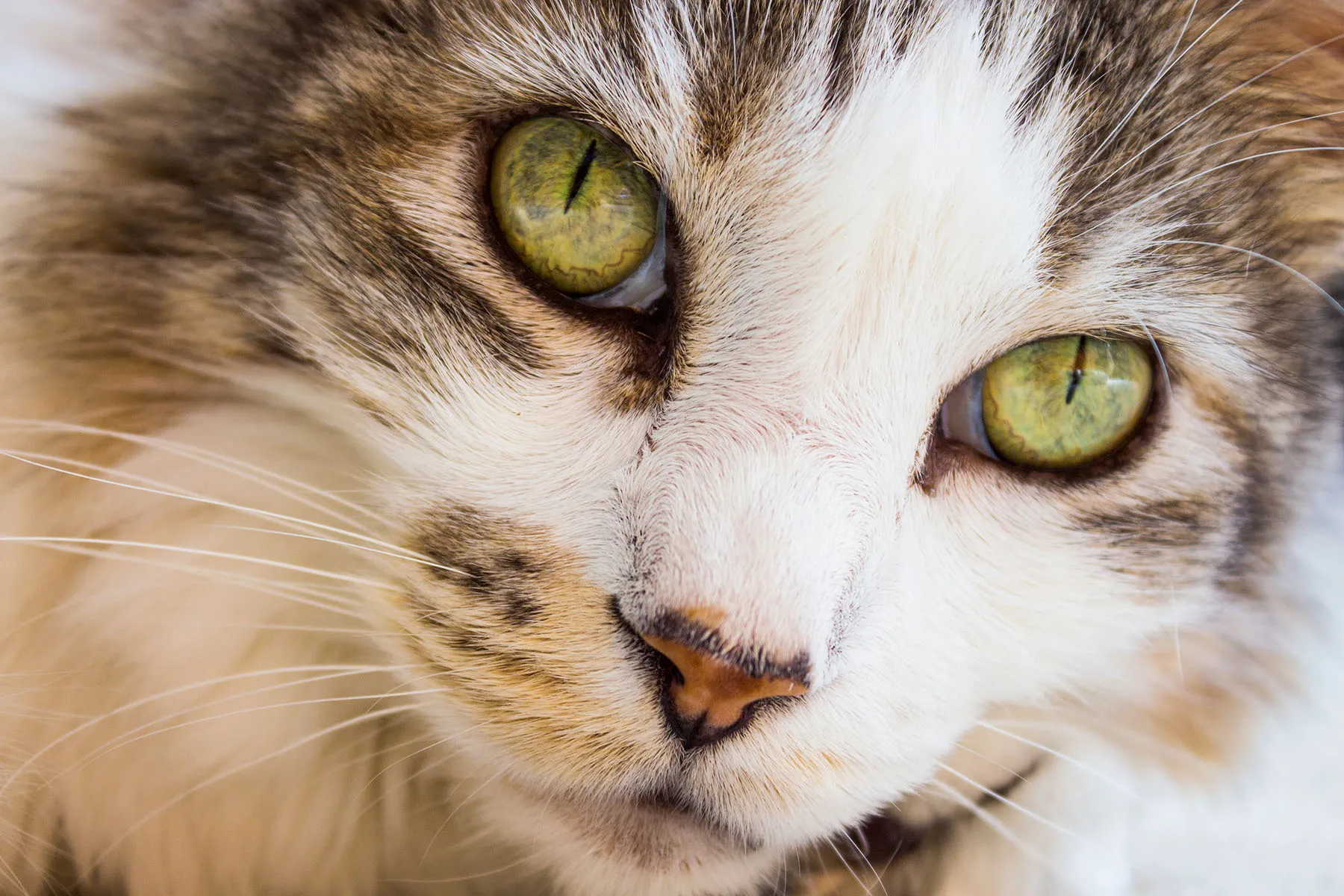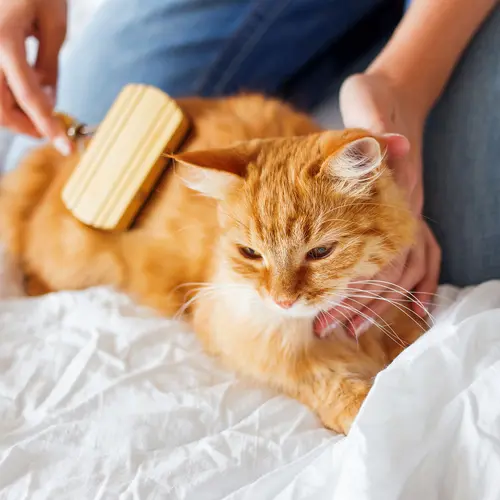
If you’ve never heard of the Pixiebob cat breed before, you aren’t alone. These smart, affectionate cats are rare and only gained recognition from The International Cat Association in the 1990s. Because this breed is excellent with people and pets, a Pixiebob may be the perfect cat to add to your family.
Characteristics of a Pixiebob
The goal of Pixiebob breeding is to create a domestic cat that looks like a North American Bobcat. The most distinctive Pixiebob characteristics include deep-set, hooded eyes, a rounded chin, facial hair that somewhat resembles mutton chops, lynx tips on the ears, and a particularly short tail. Some Pixiebobs are polydactyl, meaning their paws may have more than the usual number of toes.
Both long-haired and short-haired Pixiebob varieties have a thick double coat that’s brown and spotted. Their coats can range in color from tawny to a more reddish-brown, and their spots are darker and small, causing the Pixiebob to resemble a bobcat.
The bodies of Pixiebobs are heavy and muscular. Males typically weigh between 12 and 17 pounds, and the female Pixiebob size is between 8 and 12 pounds. On average, the Pixiebob lifespan is 13 to 15 years.
The Pixiebob personality is often compared to a dog’s. They’re active, loyal companions who bond easily with children and other pets. They’re curious cats who can be taught to walk on a harness or leash but are also perfectly content relaxing with the family. They might get up in your face trying to “help” with your daily tasks. They’re very affectionate, snuggly cats.
Caring For a Pixiebob
Pixiebobs love to be active. Although they do enjoy relaxing with their family, they require enrichment to keep them happy and healthy. Try to provide things like climbing furniture and toys to play with so they can stay entertained. You can also train your Pixiebob to walk on a leash or harness, so you can take them for a walk around your neighborhood.
In general, Pixiebobs don’t have unique nutritional needs compared to other cats. Be sure you’re feeding your cat the nutrients it needs, including a diet with enough protein and taurine. You should also make sure your cat is getting plenty of fresh, clean water.
Because Pixiebobs have a thick coat, you should brush them a few times a week to avoid matting, regardless of whether they're long- or short-haired. Like all cats, you should trim their nails, brush their teeth, and clean their ears regularly. To help maintain their claws, it’s best to provide your Pixiebob with scratching furniture, like a scratching pole.
As with all cat breeds, regular vet visits are essential for keeping your Pixiebob healthy. At a wellness visit, your vet will give your cat a physical exam. Staying up to date on your cat’s vaccines is crucial as well. Typical cat vaccines include:
- Feline distemper. Also called feline panleukopenia, feline distemper is a virus transmitted by direct contact with an infected cat or contaminated water or food. It causes a drop in immunity, which can lead to other infections and death.
- Feline herpes. This herpes virus is contracted via direct contact with an infected cat and often causes upper respiratory disease and conjunctivitis, or inflammation of the tissues around the eyes.
- Feline calicivirus. Feline calicivirus is highly infective and causes upper respiratory infections and oral diseases.
- Feline leukemia. The feline leukemia virus is passed through fluids secretions of infected cats and may lead to blood disorders and a weakened immune system. This is the most common cause of cancer in cats.
- Rabies. Rabies is a virus that attacks the nervous system and is passed through the bite of an infected animal. It's 100% fatal in animals and nearly 100% fatal in humans.
Depending on your cat’s breed, lifestyle, and where you live, your vet may also recommend the chlamydia and bordetella vaccines.
Health Problems to Watch For With a Pixiebob
Pixiebobs are genetically diverse and therefore don’t have many issues specific to the breed. However, breeders have noted a few rare Pixiebob health problems.
Cryptorchidism. Cryptorchidism is when one or both testicles fail to descend in male cats. Since the 1980s, breeders have noted a few cases of cryptorchidism in Pixiebobs.
Cryptorchidism is present at birth and is thought to be inherited, so it's not possible to prevent it. Signs of cryptorchidism include inappropriate marking behavior and aggression. Cats with this disorder may be infertile. There's also a chance that they may experience spermatic cord torsion, where the testicle twists onto itself. Undescended testicles may also become cancerous.
Your vet may diagnose your cat with cryptorchidism via ultrasound or surgery. Typically, the only treatment is to remove the undescended testicle and neuter the cat. As cryptorchidism is often inherited, breeders should not breed cats with this condition.
Dystocia. Dystocia is a term describing when a human or animal has difficulty giving birth. This can happen for many reasons but is often a result of the mother’s birth canal being too small for the size of the baby. Breeders have noted that a small percentage of Pixiebobs have dystocia, and breeders don't continue to breed those cats.
There's no way to know whether your cat will have dystocia until they're in labor. Diagnosis of dystocia includes one of the following criteria:
- The cat does not give birth within 24 hours of their rectal temperature dropping below 100°F (37.7°C)
- Strong contractions lasting 1 to 2 hours without giving birth
- Active labor lasting 1 to 2 hours without delivery
- Resting longer than 4 to 6 hours during active labor
- Obvious pain during labor
- Abnormal discharge, such as a dark green color, before birth
Dystocia may result in shock or death to the mother or kittens. The typical solution for stalled and painful labor is similar to that in humans, often requiring medical intervention and/or a cesarean section. Cats should be spayed after traumatic labor to prevent another pregnancy.
Cystic endometrial hyperplasia. Cystic endometrial hyperplasia is a uterine infection that can happen in unspayed female cats when a hormone imbalance causes cysts to grow within the uterus. This leads to a bacterial infection. As with cats with dystocia, breeders will remove cats with cystic endometrial hyperplasia from the breeding cycle.
Typical signs of cystic endometrial hyperplasia include:
- Discharge, which may contain blood, mucus, or pus
- Depression
- Lethargy
- Lack of appetite
- Vomiting
- Diarrhea
- Abdominal distension
- Increased urination
If your vet suspects that your cat has cystic endometrial hyperplasia, they’ll run blood and urine tests and do ultrasounds or x-rays. Treatment for cystic endometrial hyperplasia includes spaying the cat by removing the uterus and ovaries. Depending on the stage of infection, your Pixiebob may require intravenous fluids and antibiotics.
Hypertrophic cardiomyopathy. Hypertrophic cardiomyopathy (HCM) is a heart disease commonly diagnosed in cats. It's usually hereditary. HCM causes the walls of the cat’s heart to thicken, reducing the size of the chamber. It can lead to oxygen starvation, blood clots, congestive heart failure, and an irregular heart rhythm.
Many times, cats with hypertrophic cardiomyopathy will not show any signs of being sick. For those that do show symptoms, the signs may include difficulty breathing and lethargy from fluid accumulation around the lungs.
To diagnose your Pixiebob with HCM, your vet will perform an echocardiogram to get images of their heart. If the echocardiogram indicates thickened walls of the heart, your vet will first rule out high blood pressure and hypothyroidism. They may also perform chest radiographs and electrocardiograms.
HCM is progressive and there's no cure, but there are things you can do to manage the symptoms. This may include giving your cat medications to control their heart rate, reduce lung congestion, and prevent blood clots.
Only a few cases of HCM have been discovered in Pixiebobs over the last few decades. In some of those cases, the Pixiebob was mixed with breeds that are predisposed to HCM — like Maine Coon and Bengal cats.
Special Considerations for a Pixiebob
Pixiebobs love being part of a family, and they get along well with children and other pets. They’re especially good for families because they’re active pets. They enjoy being played with and going for walks. They’re extremely loyal, and although they can handle being left alone while you’re at work, they’ll get lonely if left for long periods of time.
You’ll notice that your Pixiebob may be somewhat vocal. They’ll make noises like chirps and chitters to get your attention and communicate with you. You may also notice them trying to “help” by investigating whatever it is you’re working on.
Pixiebob cats are not hypoallergenic.
History of Pixiebobs
Because the Pixiebob is a recent breed, there’s a decent record of its history.
In the spring of 1985, a woman named Carol Ann Brewer purchased a polydactyl spotted male kitten in Washington State. Less than a year later, she purchased a tall, patterned male cat named Keba. Both had short tails. Not long after, Keba mated with a neighbor’s cat, and Carol Ann adopted one of the resulting kittens.
This kitten, which she named Pixie, had a reddish coat and muted spotting. Carol Ann liked the look of these bobtail cats and decided to begin breeding them. In 1994, The International Cat Association accepted the Pixiebob for exhibition status.
